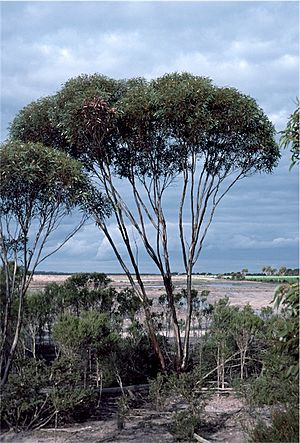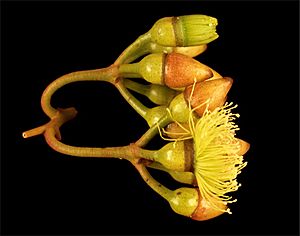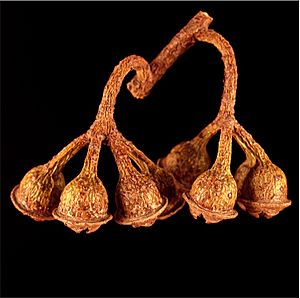Cap-fruited mallee facts for kids
Quick facts for kids Cap-fruited mallee |
|
|---|---|
 |
|
| Eucalyptus dielsii near Grass Patch | |
| Scientific classification | |
| Genus: |
Eucalyptus
|
| Species: |
dielsii
|
The Cap-fruited Mallee, known scientifically as Eucalyptus dielsii, is a special type of tree or large shrub. It's often called a "mallet" because it grows tall and straight. This plant is endemic, meaning it's only found naturally in the southwestern part of Western Australia. It has smooth bark, long, narrow adult leaves, and its flower buds grow in groups of seven. When it blooms, you'll see yellow or yellowish-green flowers. Its unique fruit is shaped a bit like a bowler hat!
Contents
What Does It Look Like?
Eucalyptus dielsii is a type of mallet, which means it's a tree that usually grows up to 8 meters (about 26 feet) tall. Unlike some other eucalypts, it doesn't have a lignotuber. A lignotuber is a woody lump at the base of the plant that helps it regrow after a fire.
Its bark is smooth and dark grey. When the old bark peels off, you can see fresh brownish and greenish bark underneath. The adult leaves are shiny green on both sides and shaped like a spear (lance-shaped). They are about 50 to 110 millimeters (2 to 4.3 inches) long and 8 to 20 millimeters (0.3 to 0.8 inches) wide. Each leaf has a small stem called a petiole, which is about 8 to 22 millimeters (0.3 to 0.9 inches) long.
The flower buds usually hang down in groups of seven. They grow on a stalk called a peduncle, which is 15 to 32 millimeters (0.6 to 1.3 inches) long. Each individual bud has its own small stem, a pedicel, about 10 to 14 millimeters (0.4 to 0.6 inches) long. When the buds are ready, they are shaped like a cylinder or oval. They are 11 to 19 millimeters (0.4 to 0.7 inches) long and 6 to 9 millimeters (0.2 to 0.4 inches) wide. Each bud has a cone-shaped cap called an operculum.
This plant has been seen flowering in November and January. Its flowers are yellow to yellowish-green. After flowering, it produces a woody fruit called a capsule. This capsule is shaped like a cylinder or half-sphere and has a rim around it. This rim makes the fruit look a lot like a bowler hat!
How Was It Named?
The Cap-fruited Mallee, Eucalyptus dielsii, was first officially described by a botanist named Charles Austin Gardner in 1926. He published his description in a scientific journal called Journal of the Royal Society of Western Australia.
The very first plant specimen used to describe this species was collected by William T. Brown in 1925. He found it near a place called Salmon Gums. The second part of its scientific name, dielsii, was chosen to honor a German botanist named Friedrich Ludwig Emil Diels. He traveled all the way to Western Australia and contributed a lot to understanding the plants of that area.
Where Does It Grow?
The Cap-fruited Mallee is found in the southern part of the Goldfields-Esperance region of Western Australia. It grows in areas with shrubs, between towns like Lake King, Ravensthorpe, and Salmon Gums.
You can find it growing in clay or sandy soils. This plant is quite tough! It can handle soils that are either acidic or basic. It is also drought tolerant, meaning it can survive long periods without much water. Plus, it's frost tolerant, so it can handle cold temperatures and frost.
Is It Endangered?
The Western Australian Government's Department of Parks and Wildlife has looked at the Cap-fruited Mallee. They have classified it as "not threatened." This means that, for now, there are enough of these plants in the wild, and they are not at risk of disappearing.
Why Is It Useful?
The Cap-fruited Mallee is sometimes grown by people. You can buy its seeds or small plants, called tube stock, from nurseries.
People plant it for a few reasons. It can be used as a windbreak, which means it helps to slow down strong winds. It's also good for erosion control, helping to keep soil from washing away. Plus, this plant is known to attract birds, which is great for local wildlife!



